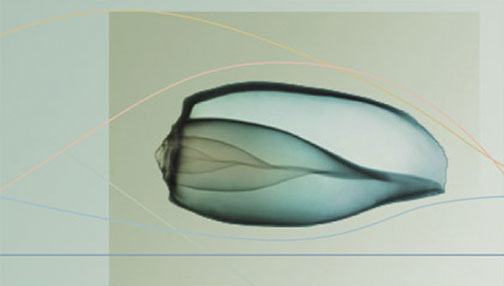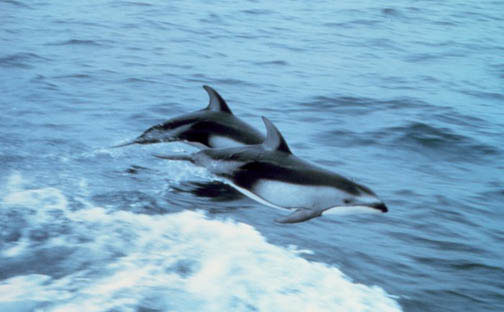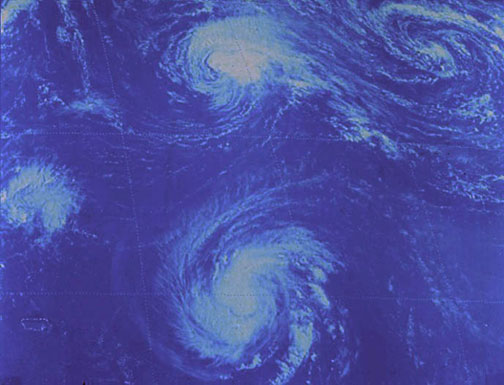
We are Water
By Jeanne Treadway
The whole world was mist once long ago and some day it will all go back to mist,
Our skulls and lungs are more water than bone and tissue
And all poets love dust and mist because all the last answers
Go running back to dust and mist.
-- Carl Sandburg
SITTING ON A HILL, in the dark, as far away from city lights as possible, you can look into the night sky and see endlessly. No matter how far you look, though, you cannot see another water planet. No computerized sky probe, with the finest lenses and cameras, has seen one, either. Our imaginations and spiritual quests insist that other realms exist and it does seem improbable that our blue Earth is indeed the only water world in creation. Yet, right now, today, Earth is the only known location of water.
Hydration is vital to all living things. Humans are able to survive weeks without food but (usually) only about three or four days without water. Minor dehydration can account for myriad illnesses, including fatigue, dizziness, headaches, and constipation. Although recent news reports state that any liquid will keep you adequately hydrated, most evidence still indicates that water is the key fluid for health. Synovial fluid, the lubricant for joints, is primarily water, as is your brain and your blood. Cells require water for metabolic reactions which keep you alive. Humans lose between four to five pints of water a day through basic bodily functions such as breathing and urination. Working outside on a hot day, you can lose as much as two pints of water an hour. As little as two percent loss of water can result in a decrease in alertness and short-term memory; it can also bring on a drop in blood pressure, fatigue and depression.
Earth and human beings reflect each other; both comprise about 70% water. Without water, nothing on this planet works. In simple terms, no joints can bend, no hearts pump, no plants grow, no thoughts can be generated. There is increasing evidence that man's upright posture, lack of fur, layer of body fat, and liquid brain developed at the shore instead of on the savannah. Besides aligning us more closely with dolphins and whales than previously thought, this early ocean home may also account for the emotional ties humans have with the sea.
Most healing methodologies incorporate water as a first principle of health. Allopathic physicians intone the mantra: Drink a minimum of eight glasses of water every day. Christians baptize new members with water. Herbalists concoct teas. Springs, rivers, and lakes are sacred and healing to peoples the world round -- think of Lourdes, the Ganges, the holy blue lake of the Taos Pueblo. Pregnant women are known to gravitate to water and research is discovering that birthing is eased and facilitated by emersion in water.
Yet, pollution of water continues unabated. Municipal, agricultural, and industrial wastes top the list of pollution sources. Polar bears in Svalbard, Norway, a wilderness 650 miles into the Arctic Circle and a critical bear habitat, have nearly the highest levels of industrial pollutants, especially PCBs, found in wild animals anywhere on Earth. Modern day-to-day living also contributes significant toxins. Even the medicines we take are fed into water reservoirs and the filtering systems in place cannot remove most of them. One plain example is that high concentrations of fluoxetine, the active ingredient in the antidepressant Prozac, have been found in lakes in Texas.
Drowning in the sea of love,
Where everyone would love to drown.
-- Stevie Nicks

Water as symbol permeates all language. Flood myths abound in cultures around the world and for many religions water was the original chaos out of which the Earth was formed. Human gestation in amniotic fluid mirrors this Earth-birthing concept, and perhaps is the foundation of these stories. Drawn originally to represent waves, the letter M is the ideogram for water, and is the reason so many names for the creatrix begin with M -- Maa, Mother, Mary. In most connotations, water and emotions are inextricably interwoven. Cups represent water and emotion (especially love and intuition) in Tarot interpretations. Tides of the ocean and rhythms of women correspond to the Moon and this symbology permeates astrology. In Five Metal Chinese Acupuncture, water aligns specifically with fear. Carl Jung, in his life-long studies of human psychology, linked emotions and water.
Emotions are traditionally designated as the feminine aspect of life, the Yin, the receptive, the nurturing. Jung assigns the elements earth and water to the passive, fire and air to the active. This certainly does not mean that only women have emotions. These slippery, difficult-to-describe, elusive things we call emotions are part of all creatures; some people believe all things experience emotion and research is beginning to validate this concept.
Scientists now know that human beings are born with different body systems that are "switched on" by both inner bodily mechanisms and interaction with their environment. Emotionally rich stimuli are critical to activating some of these inner systems, particularly those of physical growth and mental development. This probably holds true for all animals, and perhaps may be critical for all living things. Dr. Masaru Emoto found through years of experiments that even water responds to emotion and that emotions can actually change the molecular structure of water.
Emotions exist for biological purposes, even though we may not always comprehend their functions. Simply stated, love, and its permutations of compassion, caring, and sharing, binds us to each other, and greatly assists in keeping groups together. Fear warns all creatures of danger. Anger alerts us to difficulties, including physical, psychological and emotional problems. Happiness nourishes bodies and souls. Jealously, envy, pride, greed, and other "baser" emotions serve some purpose, even if that is only to improve our spiritual natures, as is contended by many religious philosophies. It seems obvious that emotions are valuable mechanisms developed to ensure health, yet millions of people have spent thousands of years repressing emotions.
Fortunately, our bodies alert us when we've become out of balance with our emotions. A sudden fright causes the body to produce adrenaline, which is good because adrenaline provides us additional strength or energy or courage to immediately respond to the fear-producing element. Frequent and regular doses of adrenaline, however, changes brain chemicals and creates a chronic state of anxiety, which in turn can physically alter the nerves in the brain. This modification makes us ill and can, in fact, harm our immune system. It appears now that repeated stimuli of any sort can result in these adverse health problems.
Humans have difficulty clearly articulating emotions. Those centuries of repression may have a hand in that, but emotions themselves are troublesome to pin down. They change as fluidly as the water they mirror. Ebbing, flowing, submerging, eddying, emotions and water go where they will, when they will. If not addressed carefully, both can be tremendously destructive. Damming rivers and manipulating emotions seem to stem from the same desire to control that which is vital to our lives but essentially uncontrollable.
Instead of control, we probably need to learn more about the function and design of emotions. We discover after laying acres of concrete to divert floods that natural riparian areas around the river will more effectively limit the damage; it would also help, of course, if we didn't build on top of flood plains, but that is another story. So it is with emotions. For example, as we mature we usually learn that whatever we fear is far less horrible if we grapple with the components of the fear within ourselves instead of suppressing it or projecting it outward. Unfortunately human phobias are escalating instead of abating; we just don't seem to be remembering our lessons well these days.
Tears of rage, tears of grief,
Why must I always be the thief?
Come to me now, you know
We're so alone
And life is brief.
-- Bob Dylan

Consciously or unconsciously, we constantly appeal to others through emotion. There are researchers who believe this bio-psychic process begins in utero; certainly humans learn and refine emotional negotiation, enticement, and manipulation from birth onward. Parents inculcate children with family specific emotional boundaries, or their absence. Schools engender cultural values, the emotion of fitting in, belonging to a certain tribe. We ingratiate ourselves to our fellow employees with false cheer and forced friendship. Religions often use shame and guilt to force us to adhere to specific moral principles. Advertisers use sex, love, fear, pride, and patriotism to convince us to buy products. No matter how we congratulate ourselves on our superior logic, rational thinking, and scientific documentation, we are emotional creatures and our emotions guide most of our actions. We have become so inured to emotional appeal that we fail to understand that the entire industrialized world economy thrives on the manipulation of our most basic emotions: fear and the need to be loved. Perfect ears of corn or big-screen televisions or 10,000 square-foot houses will not make our friends like us better nor make us better human beings. We do not require beer or cruises or new cars. Nature is not our enemy and does not need to be tamed. Patriotism does not ensure our survival.
Living is difficult. Millions of humans are starving to death. Strange and hideous diseases lurk everywhere. Jobs are scarce. Money is tight. Humans are increasingly violent. Stress is killing thousands. Everything is polluted and becoming toxic. Towers of industry are destroyed. Bombs are delivered via donkey carts. It's enough to make you weep. Some part of our rational brain tells us there should be some reason for this escalating chaos, and that if we just pinpointed the cause of all this, we could focus our energies on eliminating it.
Our ancestors felt the same way. Sometimes the cause of all their fear was the forest, sometimes it was witches or Indians, sometimes it was wild animals. The cause of our fear is closer to home, however. Barry Lopez writes in Of Wolves and Men:
"Theriophobia. Fear of the beast. Fear of the beast as an irrational, violent, insatiable creature. Fear of the projected beast in oneself. The fear is composed of two parts: self-hatred; and anxiety over the human loss of inhibitions that are common to other animals who don't rape, murder, and pillage. At the heart of theriophobia is the fear of one's own nature."
We are afraid of our anger. We are afraid of our love and we are afraid of our grief. We allow our anxieties to push us to the limit of endurance. By not facing our fears, we allow them to control us and to be preyed upon, to be manipulated and twisted. We buy stuff we don't need, really don't want, and probably won't use because we're repeatedly told those things might make us feel better. We allow the current U.S. administration and the corporate-owned media to tell us that we must be fearful. We allow them to bombard us daily, not with bombs like we hurl at the Iraqis, but with words, impassioned, irrational, hateful, fear-mongering, anxiety producing words. Weapons of Mass Destruction. If you're not with us, you're against us. Anthrax. Orange alert. Biological warfare. Nuclear weapons. Body count. Axis of Evil.
These same people also tell us that they have found the cause of our fear. First it was the Afghanis. Now it's the Iraqis. Soon it will be the North Koreans. Of course, the peace marchers, the unions, the poor, and the liberal media are always on the list. By eradicating each cause on the list, we are assured we will be safe to continue living in the land of the once free and home of the sometimes brave. It does not make you safer to be chronically afraid. Repeat. It does not make you safer to be afraid.
Our beloved water planet and our emotions — turbulent, tempestuous, and growing toxic. Both are precious. Both are necessary to our survival. As B.B. King says:
But to one who's weary
Try a little tenderness. ++
Bibliography & Resources:
Articles
"Bear Trouble." By Marla Cone, Smithsonian Magazine, April, 2003, pp. 68-74.
"Last Answers," Carl Sandburg, Chicago Poems, Henry Holt and Company, New York, 1916.
"Prozac Detected In Texas Lake Water." MSNBC, Oct. 23 , 2003.
"Sick of war and violence and BushCo reaming the planet every day? Only one thing you can really do." By Mark Morford, SFGate.com, Oct. 24, 2003.
"Water's Best, But What About the Rest?," Arthritis Today, July-August, 2003, p. 44.
Books
Balch, James F., M.D. and Phyllis A. Balch, C.N.C., Prescription for Nutritional Healing, Second Edition, Avery Publishing Group, Garden City Park, New York, 1997, p. 3 and pp. 30-33.
Joseph Campbell, editor, The Portable Jung, Penguin Books, New York, 1971.
Eisler, Riane, The Chalice & the Blade; Our History, Our Future, Harper San Francisco, 1987,pp. 21-22.
Grossinger, Richard, Planet Medicine; From Stone Age Shamanism to Post-Industrial Healing, Revised Edition, Shambhala, Boulder, 1980, 131-144.
Walker, Barbara G., The Secrets of the Tarot; Origins, History, and Symbolism, Harper & Row, Publishers, San Francisco, 1984, pp. 141-162.
Walker, Barbara G., The Woman's Encyclopedia of Myths and Secrets, Harper San Francisco, 1983, p. 1066.
Willis, Tony, Magick and the Tarot; Using Tarot to Manipulate the Unseen Forces of the Universe, Aquarian/Thorsons, New York, 1988, pp. 183-185.
Ywahoo, Dhyani, Voices of Our Ancestors; Cherokee Teachings from the Wisdom Fire, Shambhala, Boulder, 1987, pp. 117-120.
Lopez, Barry Holstun, Of Wolves and Men, Charles Scribner's Sons, New
York, 1978, p. 140-152.
Websites
Battle of Symbols
Understanding Symbols
Copyright © 2001 John Fraim
Carl Jung and Dane Rudhyar: Viewpoints on Astrology
By Tishelle Betterman
Dehydration - A Hidden Source of Fagigue
By Gordon Dupont
Drinking Water Q and Q
CBC News Online | May 2000
Emotional Appeals
Framing the issues: Language and Politics
UC Berkeley professor George Lakoff tells how conservatives use language to dominate politics
By Bonnie Azab Powell, News Center, 27 October 2003
Health
By Jacqueline Young
Panel: The Science of Memory and Emotion
"From Transient Fear to Chronic Anxiety on a Molecular Level"
Eric R. Kandel, M.D., is University Professor at Columbia University and Senior Investigator in its Howard Hughes Medical Institute.
Pregnant women may face health risks from contaminated tap water
By John Heilprin
The Associated Press
Releasing the Brakes with Water
(Excerpt from Chapter 15 of The Scientification of Love)
By Dr. Michel Odent
Learning from women
The Science of Live Water
Selling Canada's Water
Martin O'Malley and John Bowman
CBC News Online, June 2001
The Spirit of the Water Element: Why weren't we taught this in school?
By Neil R. Gumenick
As published in the California Journal of Oriental Medicine, Winter 2001 issue
Spirituality and Science
Study Reveals Impact of Fear, Anger on American Perceptions of Terrorism
Symbologies of each of the four main Watch-towers of the Majik Circle
Tarot and the Elements
Water
Water
By Jacqueline Young
Water Signs
Water, Season, and Energetics
Why We Feel: The Science of Human Emotions
Victor S. Johnston
Precautions against biological and chemical terrorism directed at food and water supplies.
Khan AS, Swerdlow DL, Juranek DD.
National Center for Infectious Diseases, Centers for Disease Control and Prevention,
Atlanta, GA 30333, USA. ask0@cdc.gov
Water Pollution and Society
By David Krantz and Brad Kifferstein
© 2004 all rights reserved by the author.
|


